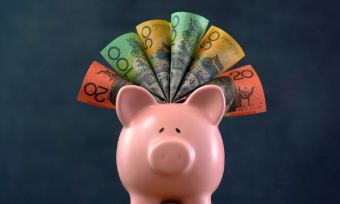Rising interest rates are good news for savers but you can still take steps to pump up your returns. Canstar money expert, Effie Zahos, shares her tips.
Rate increases may put the squeeze on mortgage-holders but they could be the best news savers have had in years.
“It’s time to pay close attention to what approach financial institutions are taking with interest rates on their savings accounts. Some will pass on the Reserve Bank’s rate hikes in full and others will try to fly under the radar and keep their rates lower,” said Canstar’s Editor-at-Large Effie Zahos.
The cash rate has increased by 175 basis points since the first hike in May but Canstar’s data shows the increase in rates on savings accounts has been much lower. The average rate on bonus accounts, for example, increased by just 98 basis points from May to August.
“Don’t leave your savings languishing in an account that is paying you anything less than a market-leading rate,” said Ms Zahos.
If you’ve got savings in the kitty here are five ways to potentially pump up your returns in a rising rate environment.
1. Be clear about your savings strategy
Finding the right savings account for you will depend on a range of factors. Think about why you are saving, how much money you have to put towards your goal, and when you’ll need to access the money.
For instance, are you looking for a savings account where you can park a lump sum? It might be the proceeds of a property sale, inheritance or a tax refund. “If you are looking for a place to stash a chunk of cash but don’t intend to top it up regularly then it can pay to look for an account with the highest rate possible,” said Ms Zahos. “This is likely to be an account offering a promotional rate for a certain period. If that’s the case be sure to check when the promo period ends.” See point four for more details.
Are you planning to save regularly? If a house deposit or an overseas holiday is on your wishlist you might put money towards your goal every payday. “If you are adding to your savings on a regular basis, check out accounts that reward savers who make deposits each month,” suggested Ms Zahos.
Or, perhaps you are happy to lock the money away so there’s no temptation to touch it. “If you think you’re likely to spend your savings when you spot something you like, then a term deposit or notice saver could be a good option for you,” said Ms Zahos.
→ Related: Locked savings account: Is it right for you?
2. Be flexible with your transaction account
You are unlikely to get a decent rate of interest if you park your money in a transaction account, so your first job should be to make sure your savings are in an account that pays you interest.
It can be a good idea to look beyond your main financial institution. “Don’t just open a savings account with the bank you have your transaction account with because it’s easy. Make sure you compare rates from different providers,” said Ms Zahos.
“If you intend to grow your savings it’s best to be flexible about where you choose to keep your transaction account,” she added. To get the best rate you may need to have a linked everyday account with the same institution. “Be prepared to move your transaction account to take advantage of the top-paying savings accounts,” said Ms Zahos. “Check if there are any fees on the linked account though. If there are high fees they can eat into your earnings.”
3. Check account conditions
Rising rates may be exciting for savers who have had to endure an earnings drought in recent years – but it’s important to check the terms and conditions.
“Banks may reserve their best rates for the under 35s or require savers to make a monthly deposit, grow their balance each month, and use the attached debit card a particular number of times each month,” said Ms Zahos.
The top rates on promo savings accounts are only available for a limited time – generally between three and five months. After the promo period ends savings rates will revert to the base rates which are much lower. “If you’re trying your hardest to reach a savings goal, promo rates could offer the leg-up you need but you shouldn’t ‘set and forget’,” said Ms Zahos.
Using a bonus saver account can be another way to give your savings a boost but again check the T&Cs. “These accounts can expect savers to do some financial gymnastics. To earn the bonus rate you may have to make a deposit each month and in some cases make no withdrawals or even lock up your savings for a short period. They may also require savers to grow their balance each month or make a certain number of card purchases,” explained Ms Zahos. “If you don’t fulfil the conditions, you can end up earning next to nothing.”
To set yourself to earn the top rate from your bonus saver, be sure to understand the conditions and put the appropriate steps in place to meet them. “If you need to deposit a certain amount each month, set an automatic transfer on payday. If you have to use your card to make a purchase five times, tick it off at the beginning of the month,” said Ms Zahos.
4. Switch when promo rates expire
Often financial institutions draw savers in with a promo rate offer. “They probably hope that savers will put switching in the too-hard basket when the promo period is over. But there’s nothing to stop you from withdrawing your money and leapfrogging to another provider offering a promo rate,” said Ms Zahos. “If you want to keep getting the best rates for your savings, keep track of when the bonus rate or promo period ends and be ready to switch.”
She added that going into a branch or making a phone call to close your account may even be an opportunity to negotiate a better rate with your financial institution and save you the trouble of switching.
“Arm yourself with information on the best rates in the market and see if your existing provider is willing to match them,” Ms Zahos suggested. “It will only take an hour or two of your time to make sure you keep getting the best rate possible to pump up your savings.”
5. Lock into ‘shorter’ term deposits
Term deposits can stop you from dipping into your savings before you reach your goal. If you are happy to lock your money away you might think that ‘longer’ term deposit rates look particularly attractive right now. But remember economists are forecasting that the cash rate is likely to continue rising this year so locking in for a long period could see you missing out on a better rate.
“In a rising rate market, it may be better to spread your money across a range of term deposits with shorter maturity dates such as three and six months so you’re poised to pounce should rates continue rising,” said Ms Zahos.
Tips for choosing a savings account
Here are a few other things to think about when you’re deciding where to put your savings.
- Check how and when interest is paid. This is especially important when it comes to term deposits as typically rates will differ depending on whether interest is paid monthly or at maturity.
- Know what fees you could be charged. If you have to open a linked transaction account are there ongoing fees? What about if you need to withdraw from a term deposit before it matures?
- Find out whether you need to maintain a minimum balance or if there is a maximum balance.
Cover image source: Maxx-Studio/Shutterstock.com
This content was reviewed by Editorial Campaigns Manager Maria Bekiaris as part of our fact-checking process.







Share this article